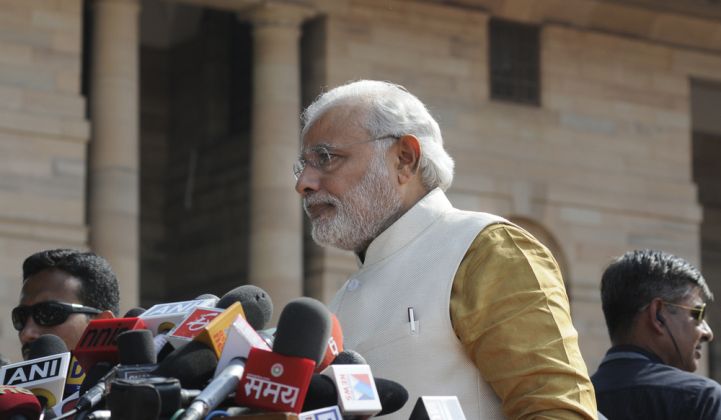Prime Minister Narendra Modi underscored India’s commitment to renewables on Monday, the first day of the United Nations climate summit in Paris, with the launch of a global coalition to rapidly expand access to solar power.
More than 120 countries have been invited to participate in the International Solar Alliance, many of which are located in Africa and Asia. Leaders from India, the U.S. and China are expected to discuss the alliance in a meeting next week.
“Today, the energy sources of the industrial age have put our planet in peril. The world must turn to the sun to power our future,” Modi said at a press briefing yesterday. “And [as] the developing world lifts billions of people into prosperity, our hope for a sustainable planet rests on a bold global initiative.”
The Indian government has pledged $30 million to set up headquarters for the alliance in New Delhi. Modi ultimately hopes to raise $400 million through participating nations.
India is also preparing to launch a $1 billion private equity fund for renewable energy projects, said Piyush Goyal, India’s energy minister, at an event leading up to the Paris climate conference.
According to the minister, India plans to ramp up the fund to $4 billion per year over the next three to four years by attracting foreign investment dollars.
Prime Minister Modi has made a strong push to grow India’s renewable energy economy, with a target to quadruple clean energy capacity to 175 gigawatts by 2022. The plan includes adding 100 gigawatts of solar PV, up from around 4 gigawatts today. Modi’s plan has a price tag of roughly $200 billion.
India has already taken several steps toward reaching its investment goal. Earlier this year, the Indian government confirmed it is in talks to secure $2 billion from the World Bank and the Asian Development Bank. Last week, the Indian government-owned IDBI Bank issued $350 million in green bonds that will also help to fund low-carbon energy projects. The program ultimately attracted orders totaling more than $1 billion.
There are roughly 300 million people living without electricity in India, making renewables as much about energy access as about environmentalism. Modi has pledged to electrify every village in India (and tracks progress in real time).
Dramatic cost improvements for solar PV have created the opportunity for a major clean energy transition in India, a country that currently relies heavily on coal. In previous climate talks, Indian negotiators have argued that coal is the only way to affordably lift its population out of poverty. This year, they've softened their stance.
However, India’s climate plan submitted for the Paris summit does not include an absolute emissions reduction target, unlike most other major economies. Rather, it seeks to slow the pace of India’s emissions growth.
The proposal includes reducing the intensity of India’s fossil-fuel emissions by 33 percent compared to 2005 levels by 2030. India will also boost the amount of electricity it generates from non-fossil-fuel sources, including nuclear energy, to 40 percent by the same year.
India is building its renewables industry as a trade case against the U.S. advances at the World Trade Organization. Sources told Bloomberg BNA that a WTO panel ruled against India in August, concluding that its domestic sourcing requirement violates world trade rules. The WTO has yet to confirm the report.
The U.S. brought the case to the WTO last year. The Dispute Settlement Body is expected to release its final report next month.



